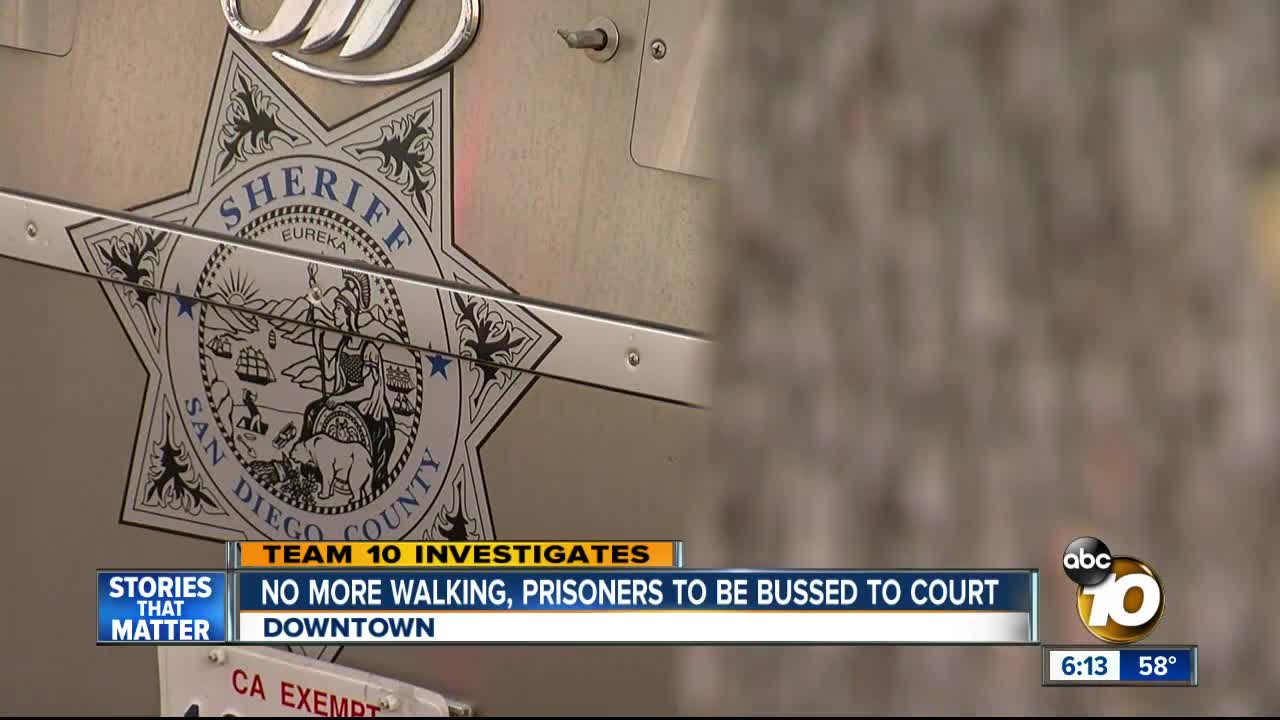SAN DIEGO — Construction crews scrambled to remove fencing on the State Street side of the new San Diego Central Courthouse. It was obvious something was about to happen. It was 7 a.m. and it was the Martin Luther King, Jr. holiday, so traffic was almost non-existent.
The trial run
By 8 a.m., two San Diego County Sheriff's prisoner transport vehicles, a bus and a box truck, pulled to the curb. People wearing safety vests and hard hats began taking measurements, checking the height and width of each vehicle and then the width of the narrow exit driveway both vehicles would have to navigate.
It was a dry run, organized after questions were raised about whether the vehicles used to transport prisoners would be able to drop-off and pick-up prisoners from the basement of the courthouse that's set to open in May.
It was a close call.
The box truck, which can transport up to 34 prisoners at a time, pulled into the underground parking area under the 22-story courthouse, turning right into a secure sally port, where prisoners will be unloaded and placed in holding cells. From the sally port, the driver cranked the wheel to make another right turn onto the exit ramp.
The truck inched forward as several workers directed the driver as he maneuvered the vehicle up a concrete ramp. There were only inches to spare on either side of the truck, but the experienced driver handled it well.
The inmate bus was a different matter. Spectators could hear a loud scraping sound as it bottomed out the concrete ramp.
The Sheriff's Department and the Judicial Council of California, which is responsible for the courthouse construction, both downplayed the problem.
A spokesman for the Judicial Council wrote: "The test was successful, except the rear bumper of the current generation bus scraped the ramp floor at two locations in the exit ramp. This scraping did not impede the bus travel. The concrete in these locations will be changed to make the ramp gradient slightly less steep; this adjustment is minor and will not change the overall cost or schedule for the new San Diego Central Courthouse."
What happened to the underground tunnel?
When plans for the new courthouse were first announced they included "a secure underground connection to the nearby San Diego Central Jail". That tunnel would allow deputies to walk prisoners the length of a short city block to the courthouse.
Because of budget cuts the California Administrative Office of the Courts cut the tunnel from the construction plans, instead building a courthouse that was "tunnel ready" should the Sheriff or county leaders decide to build it using their own money.
The old courthouse tunnel will be obsolete once the new courthouse opens and that means thousands of prisoners will ride, not walk, when they have appointments in front of a judge.
The Sheriff's Role
"We're working to make sure everything works as it should," said Ryan Keim, a spokesman for the San Diego County Sheriff's Department. "We're working with the contractor right now to find a solution, and that way we can have a seamless transition when we do move into the new courthouse in the summer."
Kein told Team 10 the tunnel is important because its a more secure and efficient way to move inmates between buildings. He said safety isn't an issue because the Sheriff's Department safely transports about 150,000 prisoners per year without incident.
"No taxpayer dollars will be spent"
That was the promise made in 2014 when ground was broken on what would become the 22-story, 704,000-square-foot courthouse. It was paid for with court fees, penalties and assessments, made possible by assembly bill 1407. No money would come from the general fund, which belongs to taxpayers.
It's a broken promise, according to Superior Court Judge Runston Maino, a vocal critic of the new courthouse. Maino says cutting the tunnel plans from the project was an expensive mistake. "I don't know what it's gonna cost the Sheriff to buy vans and to hire extra deputies to drive people over, as opposed to going through a tunnel, but in Long Beach it's about a quarter of a million dollars a year, and it is not covered by 1407 funds," said Maino, referring to another courthouse project without a tunnel to the jail.
Building a tunnel will cost an estimated $25-million. "They don't have the money to do it," said Maino. "They never had enough money to do it," and that's why Maino refers to the courthouse project as a "bait and switch".
Team 10 contacted San Diego County to see whether the tunnel connecting the central jail to the courthouse would ever be built. This was the response from a county spokesperson:
"The County Board of Supervisors has authorized County officials to discuss the possible construction of the tunnel as part of the next phase of this overall downtown courthouse project-which is the demolition of the old courthouse at 220 West Broadway. The County believes that the demolition phase and eventual repurpose of the two downtown blocks where the old courthouse currently sits would provide a second opportunity to build the much-needed tunnel. Negotiations with the owners of the old courthouse, the California Judicial Council, are ongoing. We are hopeful that these negotiations will result in a tunnel being constructed as part of the process of demolition of the old courthouse."
We'll have to wait at least a couple of years to see if the tunnel ever materializes. Until then, count on seeing Sheriff's Department vehicles shuttling prisoners back and forth from the jail.


